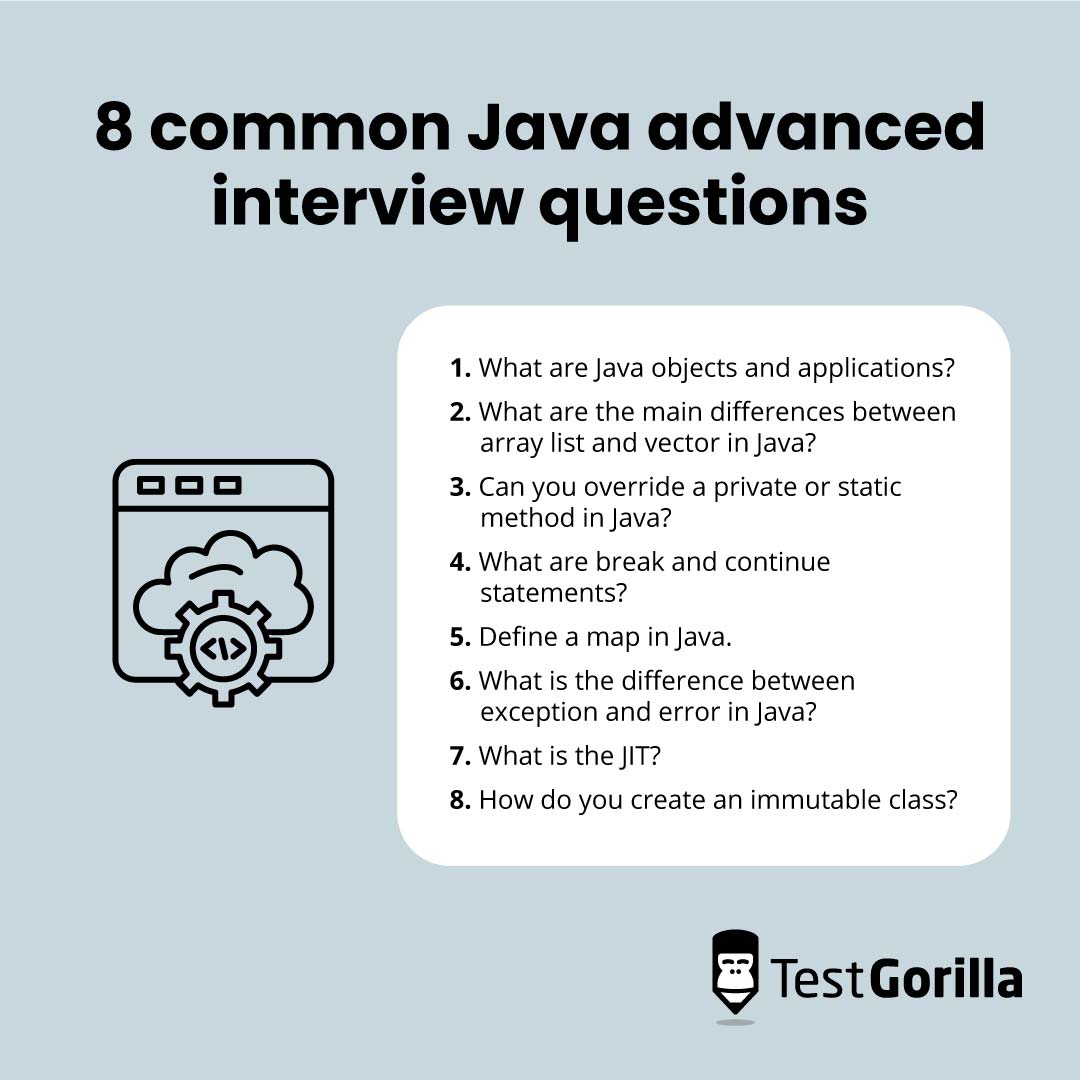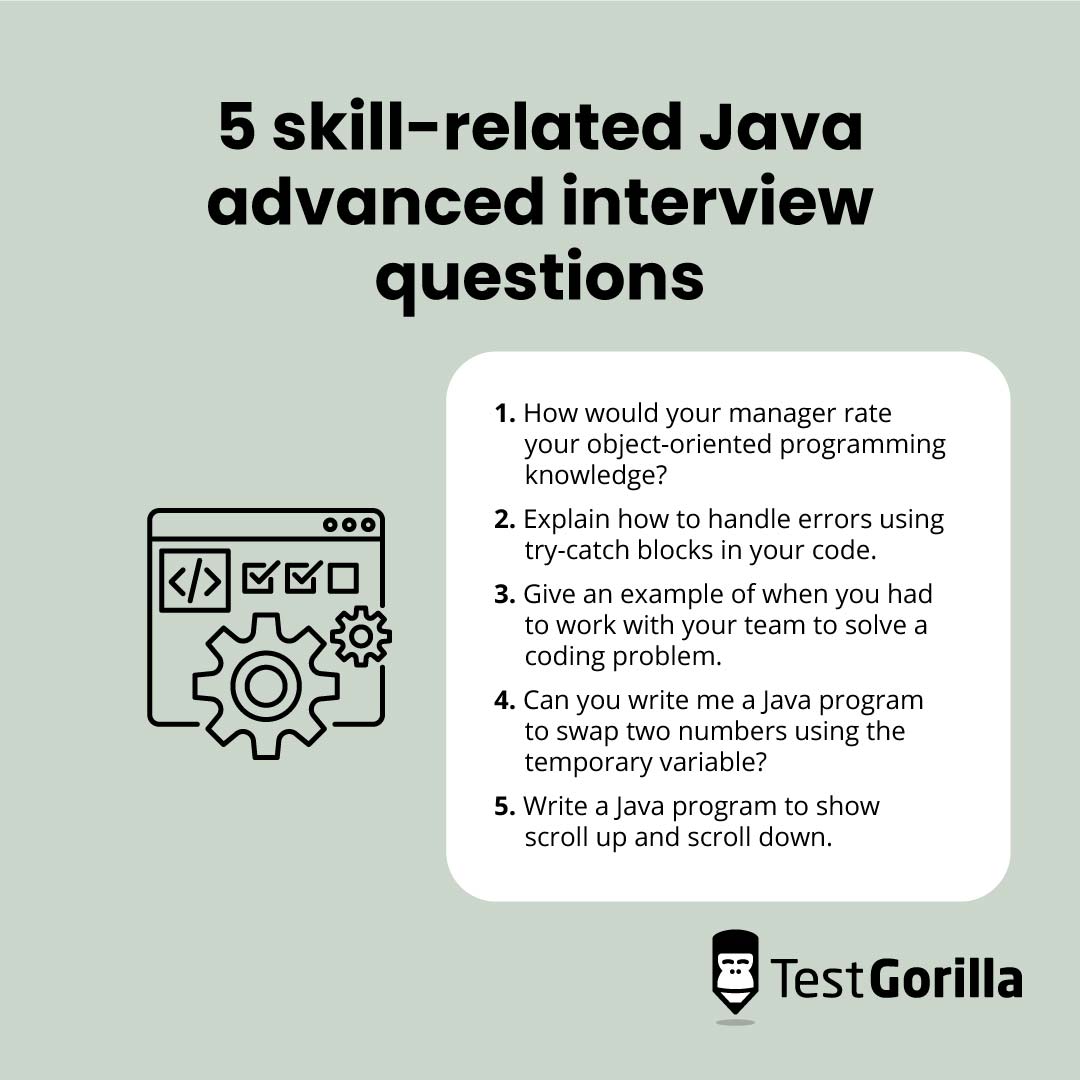Java is one of the most popular programming languages that developers use to create back-end development projects – but it does require some skill to navigate.
Due to its complex and intricate design, it’s important to hire a professional who can navigate the language with ease. An effective way to do this is to use skills tests before your interviews.
The Java Coding (Entry-Level) test is perfect for determining whether candidates have sufficient knowledge of coding fundamentals. Once applicants complete the test, you can compare their responses before choosing interview questions – this will help to ensure that you find the perfect candidate for your role.
We’ve created this list of 65+ Java advanced interview questions to help you hire the right candidate.
Table of contents
- 25 common Java advanced interview questions to ask job applicants
- 8 sample answers to common Java advanced interview questions
- 30 tough Java advanced interview questions to ask senior programmers and developers
- 8 sample answers to tough Java advanced interview questions
- 14 skill-related Java advanced interview questions to hire top talent
- 5 sample answers to skill-related Java advanced interview questions
- When should you use Java advanced interview questions in your hiring process?
- Hire technical professionals using Java advanced interview questions and skill tests
25 common Java advanced interview questions to ask job applicants
Check out these 25 common Java advanced interview questions to ask your candidates at the beginning of each interview.
1. What are Java objects and applications?
2. What is an abstract class?
3. Provide some advantages and disadvantages of Java sockets.
4. What are the different ways you can use a thread?
5. What is a checked and unchecked exception?
6. How do you create an immutable class?
7. What are pass by reference and pass by value?
8. What is the JIT?
9. Does Java support default parameter values?
10. What are the different types of inner classes?
11. What are constructors in Java?
12. Describe object cloning.
13. When can you use the super keyword?
14. What is function overriding and overloading in Java?
15. What are the main differences between array list and vector in Java?
16. Why doesn’t Java use pointers?
17. Explain an infinite loop in Java.
18. What is the difference between exception and error in Java?
19. What is reflection and why is it useful?
20. Can you override a private or static method in Java?
21. What is a marker interface?
22. What do the … dots in the method parameters mean?
23. What are the differences between GET and POST methods?
24. Define a map in Java.
25. What are break and continue statements?
8 sample answers to common Java advanced interview questions
Refer to these answers to common Java interview questions to help you make an informed hiring decision.
1. What are Java objects and applications?
Java objects form when an application executes code. On the other hand, a Java application is a program that developers create using the programming language. Candidates need to understand these basic terms to navigate Java and create dynamic web pages or games.
Use a Java Coding (Data Structures) test to see how candidates run code and effectively work with objects.
2. What are the main differences between array list and vector in Java?
Candidates, whether they’re beginners or seniors, should know how array lists and vectors work in the Java programming language.
These are essential objects that help store elements present in a java.util package. The ideal candidate will provide definitions for both objects before describing their key differences.
For context, an array list can store dynamic elements and change their size according to the package, class, or method. Vectors perform similar actions to array lists, but they synchronize to optimize storage management.
Below you will find the differences between array lists and vectors:
Array list | Vector |
Not synchronized; Faster due to the lack of multi-threading; Can increase by 50% when storing more elements; Does not define the array size; Uses an iterator to move between array lists | Synchronized; Slower due to it being thread-friendly; Automatically doubles in size when storing elements; Defines the array size; Uses enumeration and iterator to traverse array lists |
3. Can you override a private or static method in Java?
Experienced candidates will know that overriding a private or static method is not possible. You can’t create a method with the same return type and child class, as it will hide a superclass method.
This method provides access to the parent class when changing the main properties of an excepting object. So, developers won’t be able to override private or static methods since they become inaccessible in a subclass.
4. What are break and continue statements?
Break and continue statements are essential components in Java. Candidates with expert knowledge can explain these actions clearly and describe how they contribute to program development.
A break statement terminates a loop, which is a feature that follows and executes a specific set of instructions. Continue statements only move on to the next iteration of the loop and can skip particular conditions.
5. Define a map in Java.
A map in Java represents the interface of unique keys to values. It is not a subtype of the main collection interface, meaning it has different characteristics when defining a specific value.
Each key and value pair refers to an entry, which is something candidates should understand when using Java maps.
The following are some important aspects of a map:
It doesn’t have duplicate keys
Each key can use one value
6. What is the difference between exception and error in Java?
Errors show when the Java program doesn’t have enough system resources. This means the developer missed an unchecked type when coding. Meanwhile, exceptions only arise during run and compile time. They can disrupt the normal flow of an application if you don’t use the throw keyword.
It’s a good idea to send candidates a Java Coding (Debugging) test before the interview to see how they handle errors and manage exceptions in the programming language.
7. What is the JIT?
The just-in-time compiler (JIT) improves the performance of Java by using the runtime environment to compile bytecodes. These instructions can help a computer run programs with the correct programming language.
Candidates should know that JIT is an integral part of the Java virtual machine, which specifically runs class files through bytecode implementation.
8. How do you create an immutable class?
An immutable class means that developers cannot change its value once they create it. For example, String is a type of immutable class that never changes in the application. To develop this component, you need to:
Declare the class as final so you cannot extend it.
Turn the fields to private to prevent direct access.
Avoid setter methods when creating variables.
Make all mutable fields final so that you can only assign a value once.
Set the value of all fields using the constructor method.
Clone the objects in the getter methods to return a copy instead of an object reference.
30 tough Java advanced interview questions to ask senior programmers and developers
Use these 30 tough Java advanced interview questions to evaluate senior candidates’ programming skills, knowledge, and experience with using the Java programming language.
1. Does importing a package import the subpackages as well?
2. What is the difference between compile-time polymorphism and runtime polymorphism?
3. What makes the Java platform independent?
4. Explain the difference between the abstract and final keywords.
5. What is a two-dimensional array? Give some examples of two-dimensional arrays.
6. What are the break and continue statements?
7. Explain the differences between static and default interface methods.
8. What is garbage collection?
9. How can you customize the serialization process?
10. How does an exception permeate through the code?
11. Can you use == on enum?
12. In simple terms, describe a market interface.
13. Differentiate between string, stringbuilder, and stringbuffer in Java.
14. What happens if you write a static public void instead of a public static void?
15. What is the first argument of the string array in the main method?
16. Can you have multiple main methods in the same class?
17. Explain why the Java main method is static.
18. What do you understand about lazy loading in Java?
19. What are the main disadvantages of using garbage collectors in Java?
20. What is the difference between JAR and WAR files?
21. Explain the differences between the prefix and postfix increment operator with a code sample.
22. What are the different types of inheritance in Java?
23. Is there a destructor in Java?
24. What is the difference between applications and applets?
25. Does Java support global variables?
26. What is the difference between a choice and a list?
27. Why is bytecode important in Java?
28. What is the difference between the factory and abstract factory pattern?
29. Define shallow and deep cloning.
30. What is JCA in Java?
8 sample answers to tough Java advanced interview questions
Here are some sample answers to tough Java interview questions to determine which candidates best fit the open position.
1. What is the difference between compile-time polymorphism and runtime polymorphism?
Compile-time polymorphism executes all code during compilation. On the other hand, runtime polymorphism can execute the same code but in a more flexible way – it assembles the code when the program runs efficiently.
Candidates should have enough experience to know what these core concepts do in the Java programming language.
2. Explain the differences between the prefix and postfix increment operator with a code sample.
Prefix is the first to perform an increment operation. This process changes the value of variables to ensure they operate on a single command.
A postfix increment operator creates a copy of that object and returns the value from before the increment.
Below is a code sample for prefix:
int n1=10;
int n2=++n1;
This code increments n1 and then assigns to n2 automatically. This means that n2 values 11.
The following code is for postfix:
int n1=10;
int n2=n1++;
Using this code assigns n2 with the value of n1. Once it obtains that value, the code increments n1 so that n2 shares the same value as 10.
3. What is a two-dimensional array? Give some examples of two-dimensional arrays.
A two-dimensional array is a data structure that uses two subscripts. It has a collection of data in a grid with rows and columns. Candidates may describe it as an array of arrays, which is the most popular description for this component.
The following are some examples of two-dimensional arrays:
int array1[ ][ ] = new int[3][6];
double array2[ ][ ] = new double[2][5];
4. What is garbage collection?
Garbage collection is an automated process that deletes unused code. It can free up memory space and encourage applications to run efficiently, and developers need this process to prevent code overloading or the increased risk of errors.
Those without garbage collection have to implement manual memory management in the coding system themselves.
Use a Clean Code test to determine which candidates can manage and maintain code in Java.
5. Explain the differences between the abstract and final keywords.
Candidates should understand the basics of abstract and final keywords in Java. You can hire top programmers by choosing candidates who provide definitions and clearly state the differences.
The abstract keyword is a non-access modifier, meaning it can create restricted classes. A final keyword makes attributes and methods non-changeable for users. It restricts the user when they perform a specific set of actions.
Below are the key differences between abstract and final keywords:
Abstract | Final keywords |
You can specify abstract keywords with classes and methods, but not a field; The method is abstract when the developer declares it; An abstract class cannot create a class of objects | You can specify final keywords with a class, method, or field; Causes an error when the developer overrides a method during implementation; A final class can create an object of a specific class |
6. Can you have multiple main methods in the same class?
No, because the program cannot compile all pieces of code. The interviewee could state that the main method is already a defined class. Candidates should answer this question quickly if they have enough knowledge of programming languages.
7. Differentiate between string, stringbuilder, and stringbuffer in Java.
A string is a sequence of characters in Java that represent an object. Developers can manipulate strings through the string class. Strings allow you to examine individual characters in code and compare other objects when writing the source code of a computer program.
The stringbuilder creates objects that developers can modify during development. These string objects are variable-length arrays, which means you can work with a single thread in the programming language.
Stringbuffer, being another type of string, contains a particular sequence of characters that you can change through method calls. Candidates should know that stringbuffers benefit multi-threading in Java because they don’t cause errors.
8. Why is bytecode important in Java?
Bytecode is important in Java because it executes a set of high-quality instructions. This component offers portability and security for the programming language. It also means that developers don’t have to recompile source code for every platform and application.
14 skill-related Java advanced interview questions to hire top talent
Here are 14 skill-related Java advanced interview questions to better understand candidates’ Java skills.
1. How would your manager rate your object-oriented programming knowledge?
2. Can you write me a Java program to swap two numbers using the temporary variable?
3. Write a Java program to find the duplicate characters in a string.
4. Give an example of when you had to work with your team to solve a coding problem.
5. Can you overload or override static methods in Java?
6. How do you reverse a string in Java?
7. Write a Java program to show scroll up and scroll down.
8. List some good practices for creating methods in a Java class.
9. Name the different types of Java looping constructs and how you would use them.
10. When do you use an anonymous inner class?
11. Explain how to handle errors using try-catch blocks in your code.
12. How do you optimize code to help improve performance in Java?
13. What is the difference between a thread and a process?
14. List the syntaxes that create a main method for application development in Java.
5 sample answers to skill-related Java advanced interview questions
Use these sample answers to compare candidates’ responses to the skill-related Java advanced interview questions.
1. How would your manager rate your object-oriented programming knowledge?
This question gives you insight into the candidate’s personality and skills. They should tell you what they know about objects in Java and how to create them using specific actions and clean code. You can determine which candidates are honest when it comes to their programming strengths and weaknesses.
Send candidates an Object-Oriented Programming test to see how they solve programming tasks and create objects using effective and clean code.
2. Explain how to handle errors using try-catch blocks in your code.
The candidate should show their programming skills by explaining what the try-catch method is and how it works when catching errors.
This method defines a block of code that may comprise errors and exceptions. A professional developer will place the default code in a try block and run the program to detect any potential defects.
Candidates can also mention the following code:
try {
// code…
} catch (err) {
// error handling
}
3. Give an example of when you had to work with your team to solve a coding problem.
Candidates should provide an example of a problem they faced in a previous job. Their answer determines their problem-solving skills and ability to communicate with others.
For instance, one candidate might discuss how a syntax error stopped the application from running. To solve this problem, they used the try-catch block with other team members to find the grammatical error in the code.
Use a Problem-Solving test to see how candidates approach complex problems when coding in Java. You can also determine whether they have the skills to execute code properly and solve common errors.
4. Can you write me a Java program to swap two numbers using the temporary variable?
This is more of a practical question that may challenge candidates’ knowledge – give them a computer to write the code and see what they can come up with.
A temporary variable has a short lifetime since developers will discard it after implementing code. This short-lived component can still benefit the switch between two numbers in a Java program.
The following are some steps and a coding example for swapping the numbers:
Assign value of x to temp
Assign value of y to x
Assign value of temp to y
public class Main
{
public static void main(String[] args)
{
int temp;
int x = 200;
int y = 300;
//Swapping in steps
temp = x;
x = y;
y = temp;
//Verify swapped values
System.out.println(“x = ” + x + ” and y = ” + y);
}
}
Candidates with a similar example probably have more experience with using Java and writing complex code.
5. Write a Java program to show scroll up and scroll down.
Using another practical skill-related question can help you narrow down your list of candidates during the interview. They should be eager to answer and show their knowledge of designing code in a Java application.
For scrolling down:
WebDriver driver = new FirefoxDriver();
JavascriptExecutor jse = (JavascriptExecutor)driver;
jse.executeScript(“window.scrollBy(0,250)”);
For scrolling up:
jse.executeScript(“window.scrollBy(0,-250)”);
OR,
jse.executeScript(“scroll(0, -250);”);
Since most developers use Selenium to design code in Java, you can send candidates a Selenium with Python test. This assessment determines their ability to run automation and testing while writing code in different environments.
When should you use Java advanced interview questions in your hiring process?
Before you use specific interview questions, make sure you take advantage of skills tests first. These pre-employment assessments can help you screen candidates without having to scan through hundreds of job applications, saving you precious time, and ensuring that you only interview the very best candidates.
By incorporating skill tests into your hiring process, you can:
Bridge internal skill gaps
Reduce unconscious bias when hiring
Save recruitment time and costs
Enhance employer branding
Engage more with candidates
Hire the right person for the job
Be sure to choose skill tests that relate to the open position in your company. For example, you might use an Attention to Detail test to find candidates who can notice coding mistakes or identify potential weaknesses in a programming language.
Hire technical professionals using Java advanced interview questions and skill tests
Our test library can provide you with data-driven tests that enhance your hiring process. You can choose a skill assessment according to your open position and recruitment needs. These tests range from programming skills to cognitive function, so you have plenty of options.
Do you want to learn more?
Book a free 30-minute demo to join a live chat about the benefits of skill tests and how you can use them to hire talented professionals. Alongside this, you will also get a chance to ask questions about your own employment strategy.
Find a talented programmer or developer using our skill tests and Java advanced interview questions. Sign up for your free plan today.
Related posts
Hire the best candidates with TestGorilla
Create pre-employment assessments in minutes to screen candidates, save time, and hire the best talent.
Latest posts
The best advice in pre-employment testing, in your inbox.
No spam. Unsubscribe at any time.

Hire the best. No bias. No stress.
Our screening tests identify the best candidates and make your hiring decisions faster, easier, and bias-free.
Free resources
This checklist covers key features you should look for when choosing a skills testing platform
This resource will help you develop an onboarding checklist for new hires.
How to assess your candidates' attention to detail.
Learn how to get human resources certified through HRCI or SHRM.
Learn how you can improve the level of talent at your company.
Learn how CapitalT reduced hiring bias with online skills assessments.
Learn how to make the resume process more efficient and more effective.
Improve your hiring strategy with these 7 critical recruitment metrics.
Learn how Sukhi decreased time spent reviewing resumes by 83%!
Hire more efficiently with these hacks that 99% of recruiters aren't using.
Make a business case for diversity and inclusion initiatives with this data.



















